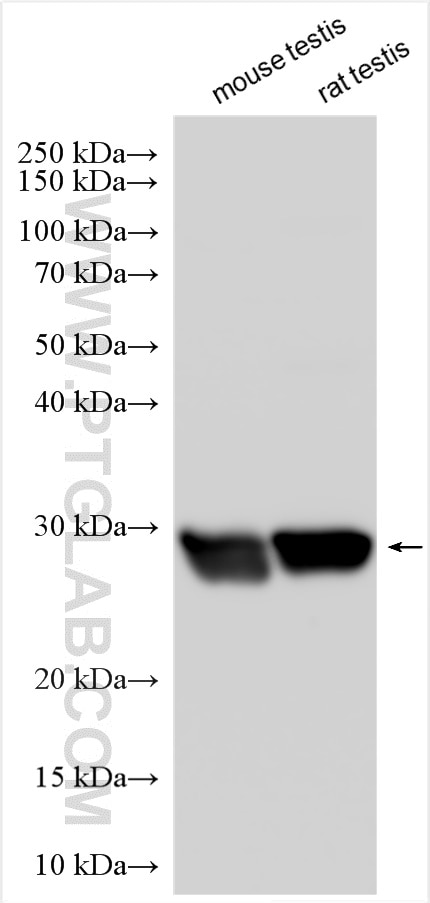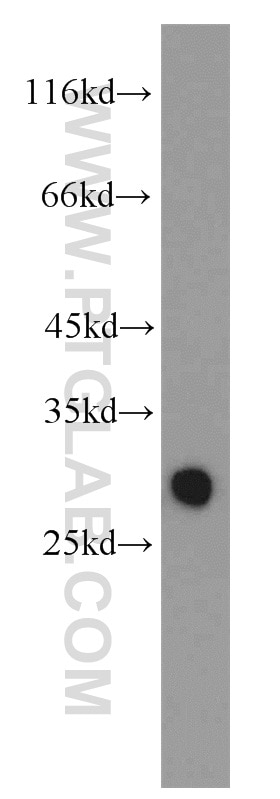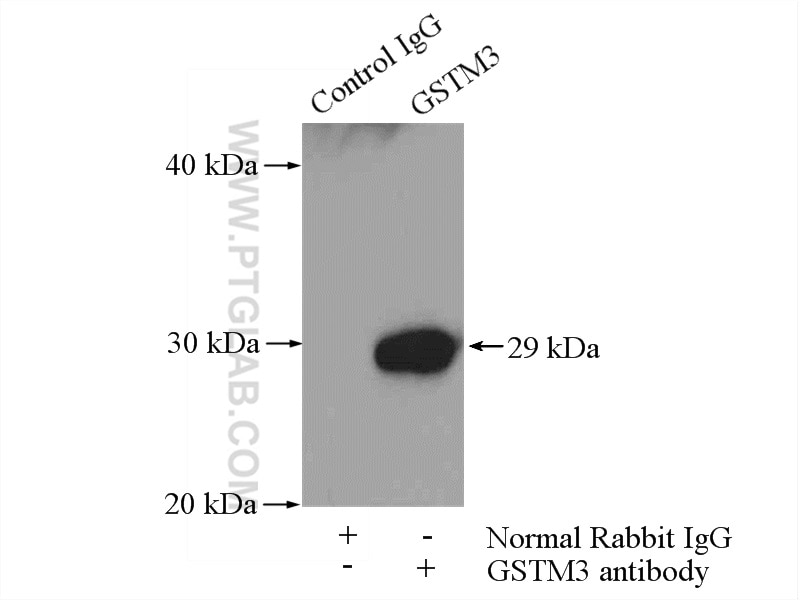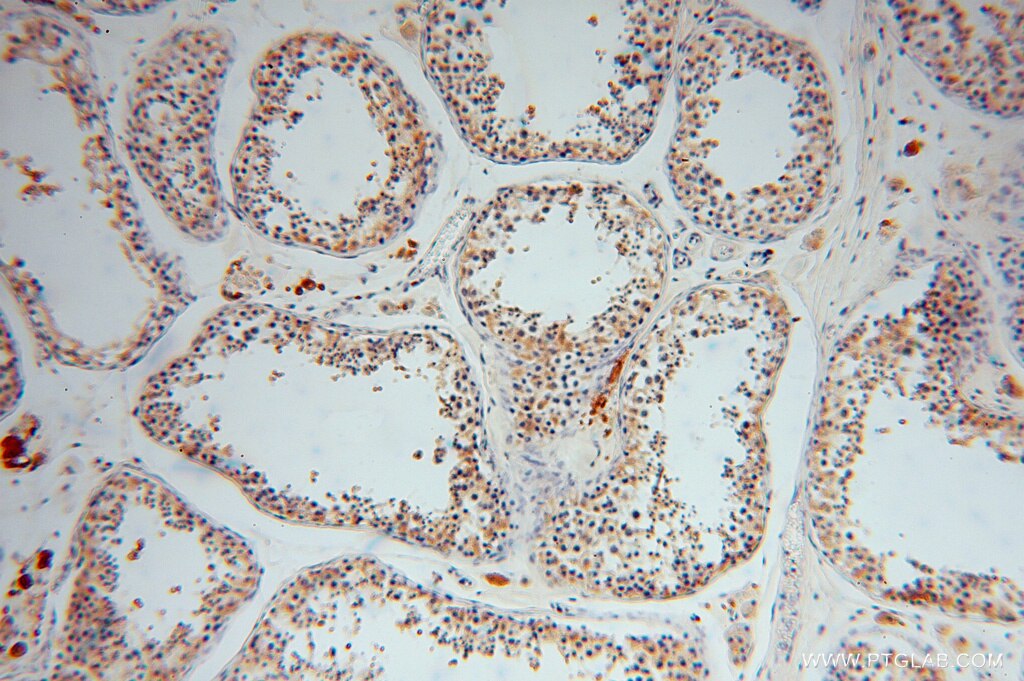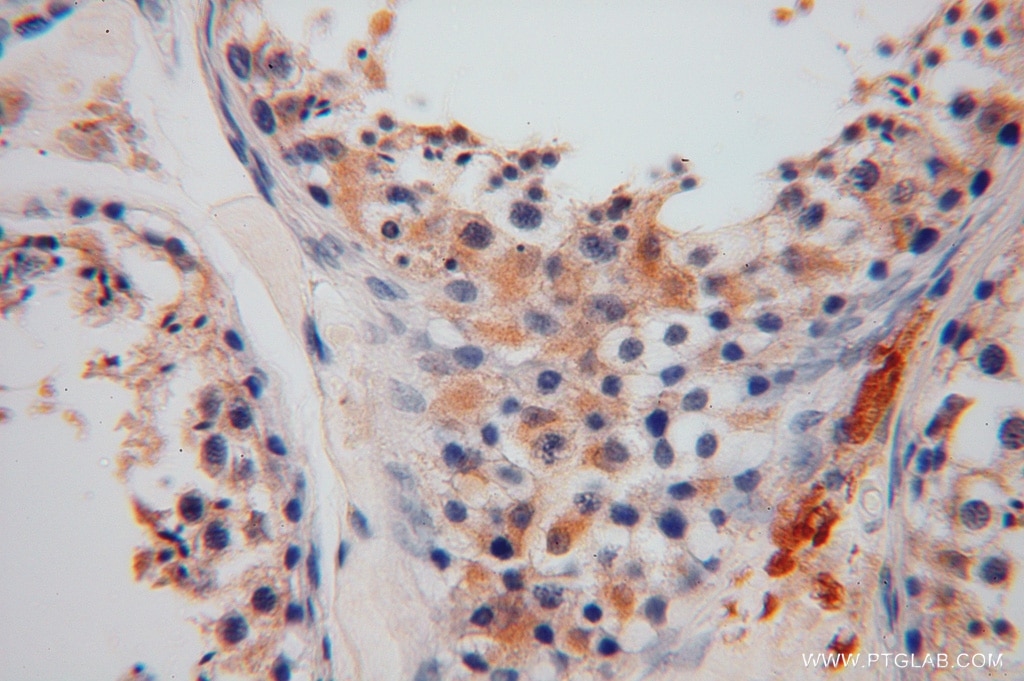- Phare
- Validé par KD/KO
Anticorps Polyclonal de lapin anti-GSTM3
GSTM3 Polyclonal Antibody for WB, IP, IHC, ELISA
Hôte / Isotype
Lapin / IgG
Réactivité testée
Humain, rat, souris et plus (1)
Applications
WB, IP, IHC, ELISA
Conjugaison
Non conjugué
N° de cat : 15214-1-AP
Synonymes
Galerie de données de validation
Applications testées
| Résultats positifs en WB | tissu testiculaire de souris, tissu testiculaire de rat, tissu testiculaire humain |
| Résultats positifs en IP | tissu testiculaire de souris |
| Résultats positifs en IHC | tissu testiculaire humain il est suggéré de démasquer l'antigène avec un tampon de TE buffer pH 9.0; (*) À défaut, 'le démasquage de l'antigène peut être 'effectué avec un tampon citrate pH 6,0. |
Dilution recommandée
| Application | Dilution |
|---|---|
| Western Blot (WB) | WB : 1:2000-1:12000 |
| Immunoprécipitation (IP) | IP : 0.5-4.0 ug for 1.0-3.0 mg of total protein lysate |
| Immunohistochimie (IHC) | IHC : 1:20-1:200 |
| It is recommended that this reagent should be titrated in each testing system to obtain optimal results. | |
| Sample-dependent, check data in validation data gallery | |
Applications publiées
| KD/KO | See 4 publications below |
| WB | See 15 publications below |
| IHC | See 6 publications below |
Informations sur le produit
15214-1-AP cible GSTM3 dans les applications de WB, IP, IHC, ELISA et montre une réactivité avec des échantillons Humain, rat, souris
| Réactivité | Humain, rat, souris |
| Réactivité citée | rat, bovin, Humain, souris |
| Hôte / Isotype | Lapin / IgG |
| Clonalité | Polyclonal |
| Type | Anticorps |
| Immunogène | GSTM3 Protéine recombinante Ag7375 |
| Nom complet | glutathione S-transferase mu 3 (brain) |
| Masse moléculaire calculée | 27 kDa |
| Poids moléculaire observé | 27-29 kDa |
| Numéro d’acquisition GenBank | BC000088 |
| Symbole du gène | GSTM3 |
| Identification du gène (NCBI) | 2947 |
| Conjugaison | Non conjugué |
| Forme | Liquide |
| Méthode de purification | Purification par affinité contre l'antigène |
| Tampon de stockage | PBS avec azoture de sodium à 0,02 % et glycérol à 50 % pH 7,3 |
| Conditions de stockage | Stocker à -20°C. Stable pendant un an après l'expédition. L'aliquotage n'est pas nécessaire pour le stockage à -20oC Les 20ul contiennent 0,1% de BSA. |
Informations générales
GSTM3 is a cytosolic enzyme involved in prostaglandin and leukotriene synthesis and in the metabolization of toxic compounds, such as chemotherapeutic drugs, insecticides, herbicides, carcinogens, and by-products of oxidative stress. GSTM3 is expressed in testis, brain, lung, and lymphocytes. GSTM3 have been reported to be dysregulated in cancers like prostate cancer and colon cancer.
Protocole
| Product Specific Protocols | |
|---|---|
| WB protocol for GSTM3 antibody 15214-1-AP | Download protocol |
| IHC protocol for GSTM3 antibody 15214-1-AP | Download protocol |
| IP protocol for GSTM3 antibody 15214-1-AP | Download protocol |
| Standard Protocols | |
|---|---|
| Click here to view our Standard Protocols |
Publications
| Species | Application | Title |
|---|---|---|
Cell Metab TMEM41B acts as an ER scramblase required for lipoprotein biogenesis and lipid homeostasis. | ||
Mol Cell SMURF2 predisposes cancer cell toward ferroptosis in GPX4-independent manners by promoting GSTP1 degradation | ||
Cell Syst Rare Disease Mechanisms Identified by Genealogical Proteomics of Copper Homeostasis Mutant Pedigrees. | ||
Cancer Lett GSTM3 deficiency impedes DNA mismatch repair to promote gastric tumorigenesis via CAND1/NRF2-KEAP1 signaling.
| ||
Part Fibre Toxicol Protein target identification and toxicological mechanism investigation of silver nanoparticles-induced hepatotoxicity by integrating proteomic and metallomic strategies. |
